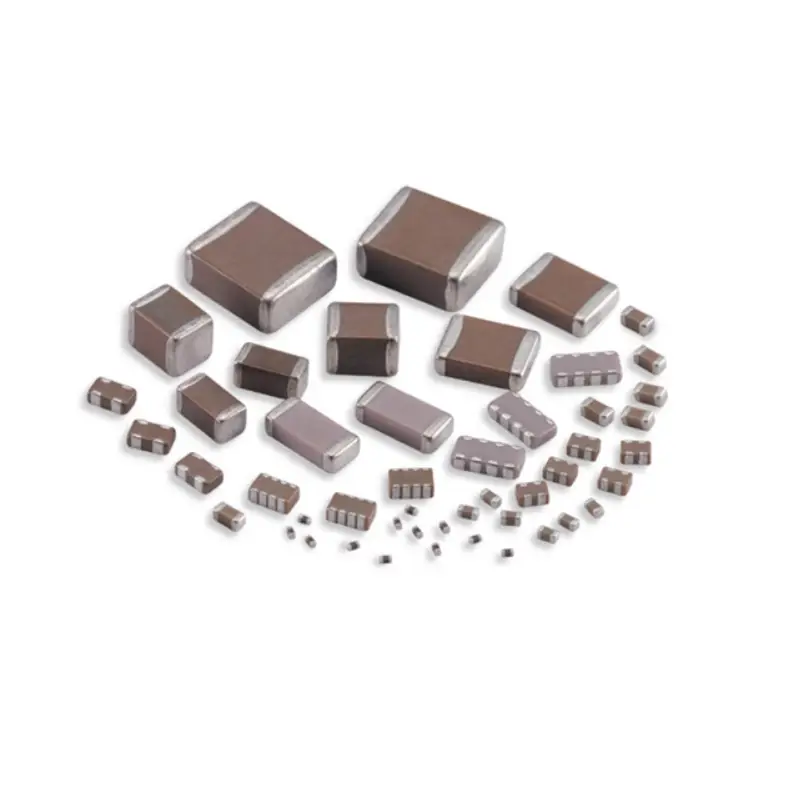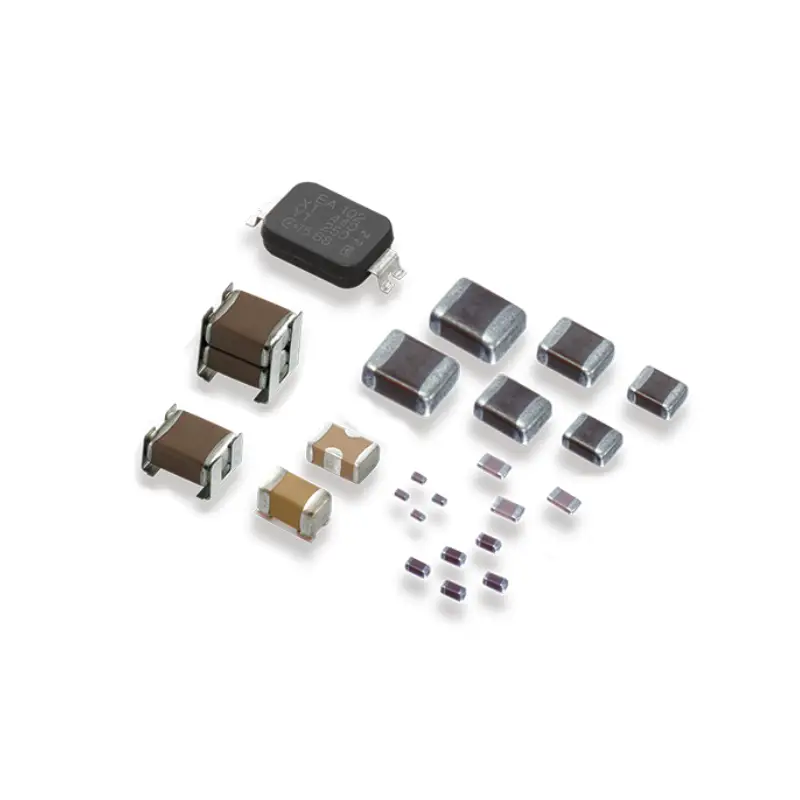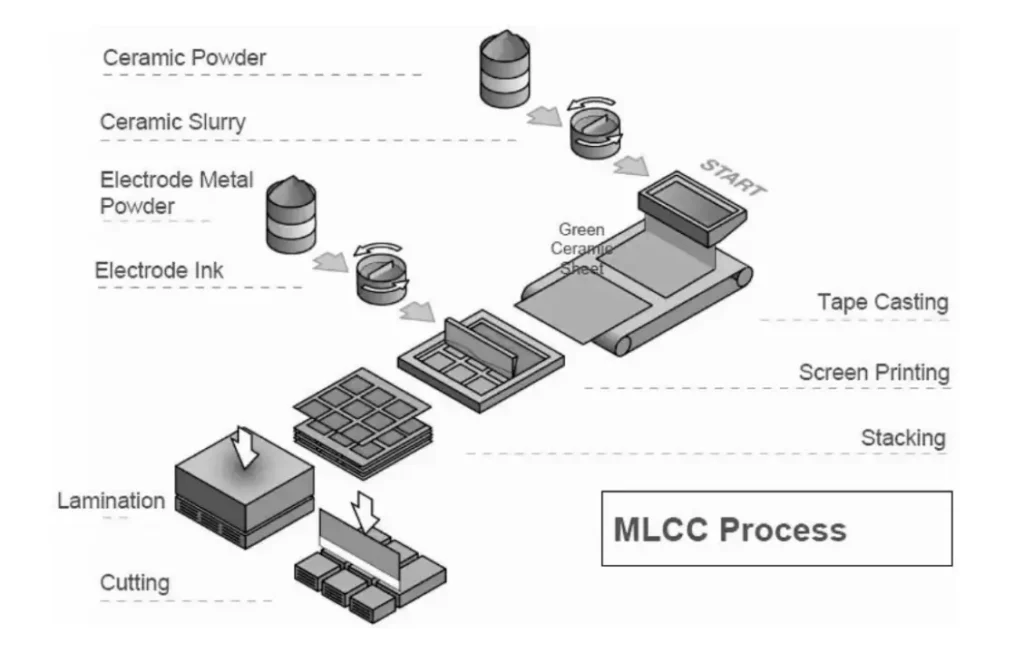MLCC Capacitor
MLCC capacitors (multilayer ceramic capacitor) are tiny, high-performance capacitors used in various electronic devices. They offer high capacitance in a small package, excellent stability, and low ESR. Ideal for filtering, decoupling, and high-frequency applications.
Get MLCC Capacitors with Affordable Prices
Need high-quality MLCC capacitors without breaking the bank? We offer a wide range of affordable MLCC capacitors to suit your specific needs. From small-scale hobby projects to large-scale industrial applications, our cost-effective solutions ensure optimal performance without compromising your budget.

MLCC capacitor construction
Multilayer Ceramic Capacitors (MLCCs) are tiny electronic components that pack a lot of capacitance into a small package. They are constructed using a layered structure:
- Dielectric Layers: Thin layers of ceramic material, typically barium titanate, form the dielectric. This material has a high dielectric constant, allowing for high capacitance in a small volume.
- Electrode Layers: Alternating layers of conductive material, usually nickel, are deposited on the dielectric layers. These electrodes connect the individual capacitor cells in parallel.
- Chip Formation: The layered structure is stacked and pressed into a solid block.
- Terminalization: Metal terminals are attached to the top and bottom of the chip, providing electrical connections.
MLCC Capacitor Datasheet
MLCC capacitor datasheets provide detailed technical specifications for each specific product. These documents are essential for engineers and designers to select the appropriate capacitor for their applications.


MLCC capacitor Types
MLCC capacitors are primarily categorized into two types:
Class 1:
- High stability
- Low capacitance
- Low loss
- Ideal for high-frequency applications
Class 2:
- High capacitance
- Lower stability
- Higher loss
Suitable for decoupling and filtering in power supplies and digital circuits
Multilayer Ceramic Capacitor Manufacturing Process Capacitor

Here’s a basic guide of the multilayer ceramic capacitor manufacturing process:
Step 1: Raw Material Preparation
- Ceramic powders (e.g., barium titanate) are mixed with additives to achieve desired dielectric properties.
- These materials are then finely ground and processed to create a homogenous slurry.
Step 2: Tape Casting
- The ceramic slurry is carefully coated onto a carrier film using a doctor blade.
- This creates thin, uniform sheets of ceramic material.
Step 3: Electrode Printing
- Internal electrodes (typically made of metals like nickel or palladium) are printed onto the ceramic sheets using a screen printing process.
- This creates alternating layers of ceramic and electrode material.
Step 4: Lamination
- The printed ceramic sheets are stacked together in the desired number of layers.
- This stack is then pressed and laminated to form a cohesive green sheet.
Step 5: Cutting
- The laminated green sheet is precisely cut into individual chips, each representing a single capacitor.
Step 6: Sintering
- The cut chips are fired at high temperatures (typically 1000-1300°C) in a controlled atmosphere.
- This process densifies the ceramic, forms the desired crystalline structure, and integrates the electrodes.
Step 7: Termination
- External electrodes (typically made of copper or nickel) are applied to the sintered chips.
- This allows for electrical connection to the external circuitry.
Step 8: Testing and Packaging
- The completed capacitors undergo rigorous electrical testing to ensure they meet performance specifications.
- Finally, they are packaged for shipment and distribution.
Why Choose Our MLCC Capacitors
Superior Performance:
- High Capacitance in Small Size: Our MLCC capacitors offer exceptional capacitance density, allowing you to pack more performance into smaller devices.
- Excellent Stability: Experience consistent performance across a wide temperature range, ensuring reliable operation in various environments.
- Low ESR and ESL: Minimize power loss and signal distortion with our low-impedance capacitors.
Extensive Product Range:
- Diverse Capacitance and Voltage Ratings: Choose from a wide range of options to meet your specific design needs.
- Custom Solutions: Our engineering team can work with you to develop tailored solutions for your unique applications.
- Global Supply Chain: Ensure timely delivery and consistent supply with our global sourcing network.
Unmatched Reliability:
- Robust Construction: Our MLCCs are built to withstand harsh conditions, including thermal shock, vibration, and humidity.
- Long Lifespan: Benefit from extended product life with our high-quality materials and advanced manufacturing processes.
- Rigorous Testing: Each capacitor undergoes stringent quality control measures to guarantee reliability and durability.
Competitive Pricing:
- Cost-Effective Solutions: We offer high-quality MLCC capacitors at competitive prices without compromising performance.
- Bulk Purchasing Discounts: Take advantage of our volume discounts to further reduce costs.
- Optimized Supply Chain: Our efficient supply chain management helps us keep prices low while maintaining quality.
MLCC Capacitor FAQs
What are MLCC Capacitors?
Multilayer Ceramic Capacitors (MLCCs) are tiny, high-performance capacitors used in a wide range of electronic devices. They are known for their high capacitance in a small package, excellent stability, and low ESR (Equivalent Series Resistance).
What is MLCC Capacitor scrap value?
The scrap value of MLCC capacitors primarily depends on the presence of precious metals like palladium and silver within them. While not all MLCCs contain these metals, many do, especially those manufactured in recent years.
Factors Affecting Scrap Value:
- Precious Metal Content: The quantity and type of precious metals present significantly influence the scrap value.
- Age and Manufacturing Date: Older MLCCs may contain more valuable metals due to differences in manufacturing processes.
- Quantity and Quality of the Scrap: Larger quantities of high-quality MLCC scrap can command higher prices.
Determining Scrap Value:
- Professional Recycling Services: Companies specializing in precious metal recovery can accurately assess the value of your MLCC scrap. They have the expertise and equipment to identify and extract valuable metals.
- Online Marketplaces: Platforms like eBay can provide insights into current market prices for MLCC scrap, but it’s important to verify the quality and quantity of the material being sold.
Recycling MLCCs:
If you have a significant amount of MLCC scrap, consider recycling it through a reputable service. This not only helps recover valuable resources but also contributes to environmental sustainability.
Important Note:
It’s crucial to handle MLCC capacitors and other electronic components with care, as they may contain hazardous substances. Always follow proper recycling guidelines and safety procedures.
Can I choose MLCC Capacitor sizes?
The scrap value of MLCC capacitors primarily depends on the presence of precious metals like palladium and silver within them. While not all MLCCs contain these metals, many do, especially those manufactured in recent years.
Factors Affecting Scrap Value:
- Precious Metal Content: The quantity and type of precious metals present significantly influence the scrap value.
- Age and Manufacturing Date: Older MLCCs may contain more valuable metals due to differences in manufacturing processes.
- Quantity and Quality of the Scrap: Larger quantities of high-quality MLCC scrap can command higher prices.
Determining Scrap Value:
- Professional Recycling Services: Companies specializing in precious metal recovery can accurately assess the value of your MLCC scrap. They have the expertise and equipment to identify and extract valuable metals.
- Online Marketplaces: Platforms like eBay can provide insights into current market prices for MLCC scrap, but it’s important to verify the quality and quantity of the material being sold.
Recycling MLCCs:
If you have a significant amount of MLCC scrap, consider recycling it through a reputable service. This not only helps recover valuable resources but also contributes to environmental sustainability.
Important Note:
It’s crucial to handle MLCC capacitors and other electronic components with care, as they may contain hazardous substances. Always follow proper recycling guidelines and safety procedures.
how to test ceramic capacitor using analog multimeter?
Testing a Ceramic Capacitor with an Analog Multimeter
While not as precise as specialized capacitor testers, an analog multimeter can provide a basic assessment of a ceramic capacitor’s condition. Here’s how:
1. Set the Multimeter to Resistance Mode:
- Select the highest resistance range on your multimeter.
2. Connect the Multimeter Probes:
- Touch the multimeter probes to the capacitor’s leads.
3. Observe the Needle Movement:
- Good Capacitor: The needle should initially deflect towards zero resistance (low resistance), then gradually move towards infinity (high resistance) as the capacitor charges.
- Shorted Capacitor: If the needle remains at zero resistance, the capacitor is likely shorted.
- Open Capacitor: If the needle remains at infinity (no deflection), the capacitor is likely open.
Important Notes:
- Analog Multimeter Limitations: Analog multimeters may not be able to accurately measure the capacitance value of the capacitor.
- Visual Inspection: Before testing, visually inspect the capacitor for any signs of physical damage, such as cracks or bulging.
- Safety Precautions: Always discharge the capacitor before testing, especially if it was previously connected to a circuit. You can do this by shorting the leads together with a screwdriver.
This method provides a basic assessment. For more accurate testing, consider using a dedicated capacitor tester or a digital multimeter with capacitance measurement capabilities.
Remember: Always prioritize safety when working with electronic components. If you are unsure about any aspect of this procedure, consult with an experienced electronics technician.
mlcc vs ceramic capacitor
MLCC vs. Ceramic Capacitor: A Quick Comparison
While all MLCCs are ceramic capacitors, not all ceramic capacitors are MLCCs.
- A broad category of capacitors that use ceramic as the dielectric material.
- Can be single-layer or multilayer.
- Offer a wide range of capacitance values, voltage ratings, and temperature characteristics.
MLCC (Multi-Layer Ceramic Capacitor):
- A specific type of ceramic capacitor with a layered structure.
- Multiple layers of ceramic dielectric are interleaved with conductive layers, significantly increasing capacitance in a small package.
- Ideal for high-frequency applications due to their low ESR (Equivalent Series Resistance).
- Commonly used in electronic devices like smartphones, computers, and automotive systems.
Key Differences:
| Feature | MLCC | Ceramic Capacitor |
|---|---|---|
| Structure | Multi-layered | Single-layer or multilayer |
| Capacitance | High capacitance in small size | Varies depending on type and size |
| ESR | Typically lower | Varies depending on type and size |
| Cost | Generally more expensive | Varies depending on type, size, and quantity |
In essence, while all MLCCs are ceramic capacitors, not all ceramic capacitors are MLCCs.
The choice between the two depends on specific application requirements, such as capacitance, voltage rating, temperature range, and frequency response.
mlcc vs electrolytic capacitor
MLCC vs. Electrolytic Capacitor:
MLCC (Multi-Layer Ceramic Capacitor) and Electrolytic Capacitor are two common types of capacitors used in electronic circuits, each with its own strengths and weaknesses.
MLCC Capacitors
- High capacitance in a small package: Ideal for high-density circuit boards.
- Excellent stability: Less affected by temperature and aging.
- Low ESR (Equivalent Series Resistance): Suitable for high-frequency applications.
- Polarity-independent: Can be used in any orientation.
Electrolytic Capacitors
- High capacitance values: Can store large amounts of energy.
- Lower cost: More economical for large capacitance needs.
- Polarity-sensitive: Must be connected with the correct polarity.
- Lower stability and reliability: Can degrade over time, especially at high temperatures.
- Higher ESR: Less suitable for high-frequency applications.
When to Use Which:
MLCCs:
- High-frequency applications
- Decoupling and bypass capacitors
- Timing circuits
- Filter circuits
Electrolytic Capacitors:
- Power supply filtering
- Energy storage
- Buffering circuits
MLCCs are generally preferred for high-frequency applications and smaller capacitance values, while electrolytic capacitors are better suited for larger capacitance values and lower-frequency applications. However, advancements in MLCC technology are enabling them to replace electrolytic capacitors in many applications, especially in smaller, more compact devices.
multilayer ceramic capacitor vs single layer
Multilayer Ceramic Capacitor (MLCC) vs. Single-Layer Ceramic Capacitor
Multilayer Ceramic Capacitor (MLCC):
- Structure: Multiple layers of ceramic dielectric material are interleaved with conductive layers, forming a compact, high-capacitance device.
- Advantages:
- High capacitance in a small package
- Low ESR (Equivalent Series Resistance)
- Excellent stability
- Wide range of capacitance and voltage ratings
- Disadvantages:
- Can be more expensive than single-layer capacitors, especially for lower capacitance values
- May have lower self-resonant frequency compared to single-layer capacitors, limiting high-frequency performance in some applications
Single-Layer Ceramic Capacitor:
- Structure: A single layer of ceramic dielectric material sandwiched between two conductive electrodes.
- Advantages:
- Simple and reliable construction
- Lower ESR compared to MLCCs at high frequencies
- Can be more cost-effective for lower capacitance values
- Disadvantages:
- Lower capacitance density compared to MLCCs
- Larger physical size for the same capacitance value
Key Differences:
| Feature | MLCC | Single-Layer Ceramic Capacitor |
|---|---|---|
| Structure | Multi-layered | Single-layer |
| Capacitance Density | High | Lower |
| ESR | Lower | Lower at high frequencies |
| Cost | Higher | Lower |
| Size | Smaller | Larger for equivalent capacitance |
Choosing the Right Capacitor:
The choice between MLCC and single-layer ceramic capacitors depends on the specific requirements of the application:
- High capacitance in a small package: MLCCs are the preferred choice.
- High-frequency applications: Single-layer ceramic capacitors may be more suitable due to their lower ESR at higher frequencies.
- Cost-sensitive applications: Single-layer ceramic capacitors can be a more economical option, especially for lower capacitance values.
By understanding the characteristics of each type, you can select the most appropriate capacitor for your electronic design.
What are multilayer ceramic capacitor applications?
Multilayer Ceramic Capacitors (MLCCs) are ubiquitous in modern electronics due to their versatility and high performance. They find applications across a wide spectrum, from consumer electronics to industrial equipment.
Decoupling and Filtering: MLCCs are essential for decoupling circuits, where they help to stabilize power supplies by filtering out high-frequency noise and providing a stable voltage source to integrated circuits. This is crucial for preventing malfunctions and ensuring reliable operation in digital circuits. They also play a vital role in filtering out unwanted signals in various electronic systems, such as audio and radio frequency (RF) circuits.
High-Frequency Applications: Their low Equivalent Series Resistance (ESR) and high self-resonant frequency make them ideal for high-frequency applications. They are widely used in RF circuits, such as filters, oscillators, and mixers, where their ability to handle high frequencies with minimal losses is critical.
Automotive Electronics: In the automotive industry, MLCCs are integral to various electronic systems, including engine control units (ECUs), infotainment systems, and advanced driver-assistance systems (ADAS). Their compact size and high reliability are crucial for meeting the demands of modern vehicles.
Consumer Electronics: MLCCs are found in virtually all consumer electronics devices, from smartphones and laptops to televisions and cameras. They play a crucial role in enabling the high performance and miniaturization of these devices.
Industrial Applications: MLCCs are used in various industrial applications, including power electronics, motor control, and industrial automation. Their ability to withstand harsh environments and operate reliably under demanding conditions makes them suitable for these applications.
Multilayer Ceramic Capacitors are indispensable components in modern electronics, enabling high performance, miniaturization, and reliable operation across a wide range of applications.